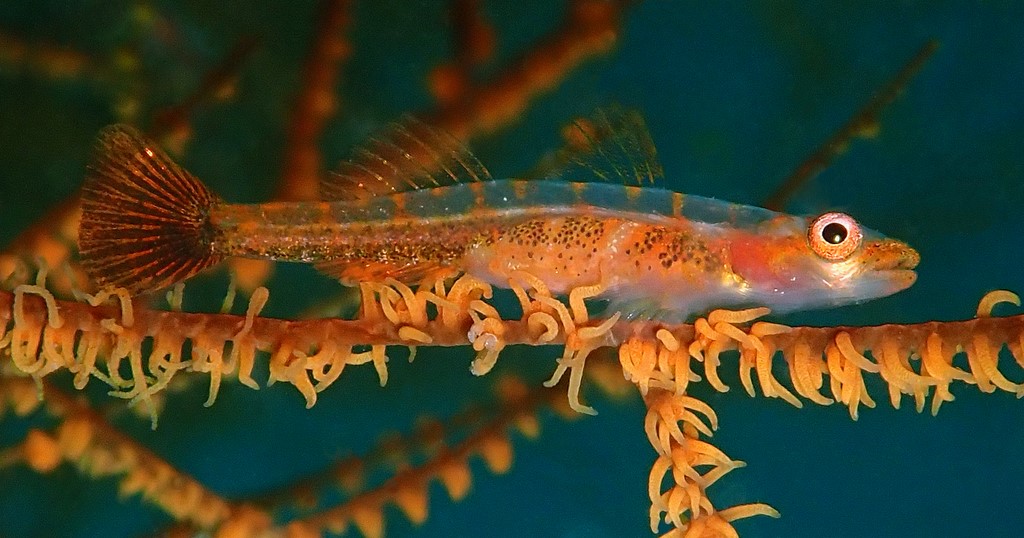BRYANINOPS TIGRIS - (LARSON, 1985)
Picture courtesy of: Alain Daoulas
Actinopterygii (Gigaclass) > Actinopteri (Class) > Teleostei (Subclass) > Gobiiformes (Order) > Gobioidei (Suborder) > Gobiidae (Family) > Gobiinae (Subfamily) > Bryaninops (Genus)
Gobie nain du corail noir, Antipatharia goby, Black coral goby, Blackcoral whipgoby, Black-coral goby, Sujigurogarasuhaze, スジグロガラスハゼ, 虎紋珊瑚鰕虎魚,
Description
Dorsal spines (total): 6-7; Dorsal soft rays (total): 7-8; Anal spine: 1; Anal soft rays: 8-9. Pectoral fin rays: 12-14 (usually: 13), lower 3 or 4 rays unbranched and thickened; Anteriormost scales on body usually reaching to above or a little anterior to pectoral fin base; Longitudinal scale series: 32-59 (mean scale count: 47); Transverse rows of scales backwards: 8-12; Body elongate, the depth at origin of anal fin 11.6-14.5 % in SL; Head width about equal to head depth; Snout length about equal to orbit diameter; Gill opening small, reaching ventrally to below or just anterior to lower edge of pectoral fin base; Mouth slightly inferior; A recurved canine tooth (or pair of teeth) at side of lower jaw; Tongue tip bilobed or trilobed. Lower edge of preopercle slightly scalloped; Caudal fin truncate with rounded corners; Pelvic fins short, round, and cup-like, the pelvic spines and frenum thickened. Max. length: 2.5 cm SL. Depth range: 15 - 53 m.
Color
Dorsal two-fifths of body transparent, crossed by six or seven narrow bars that may be yellow, dusky orange, or red, with a small spot of the same color dorsally between each bar; A white line above vertebral column; Lower three-fifths of body dusky to blackish orange. Eyes golden-red.
Etymology
Bryaninops: from the former similar or related genus Bryanina now, Sicyopterus + from Ancient Greek, óps = eye, face, appearance.
tigris: from Ancient Greek, tígris = tiger. Referring to brown and golden colors in life and its secretive behavior.
Original description: Bryaninops tigris Larson, 1985 - Type locality: on dropoff halfway between Bird and South islands, Lizard Island, Great Barrier Reef, Australia, depth 18-20 meters.
Distribution
Red Sea; Indo-West Pacific: East Africa (Mozambique), Gulf of Oman, Maldives and Chagos Archipelago (British Indian Ocean Territory), east to Hawaiian Islands (U.S.A.) and Society Islands (French Polynesia), north to Ryukyu Islands (Japan), south to Australia and New Caledonia.
Biology
Inhabit deep slopes, subject to strong currents, with isolated outcrops of black corals. Benthic. Found in small groups. Eggs are laid on a branch section after removing the polyps and guarded by the male. Associated with antipatharian corals. Dart out to feed on small animals of the plankton.
Last update: 25, May 2024
Actinopterygii (Gigaclass) > Actinopteri (Class) > Teleostei (Subclass) > Gobiiformes (Order) > Gobioidei (Suborder) > Gobiidae (Family) > Gobiinae (Subfamily) > Bryaninops (Genus)
Gobie nain du corail noir, Antipatharia goby, Black coral goby, Blackcoral whipgoby, Black-coral goby, Sujigurogarasuhaze, スジグロガラスハゼ, 虎紋珊瑚鰕虎魚,
Description
Dorsal spines (total): 6-7; Dorsal soft rays (total): 7-8; Anal spine: 1; Anal soft rays: 8-9. Pectoral fin rays: 12-14 (usually: 13), lower 3 or 4 rays unbranched and thickened; Anteriormost scales on body usually reaching to above or a little anterior to pectoral fin base; Longitudinal scale series: 32-59 (mean scale count: 47); Transverse rows of scales backwards: 8-12; Body elongate, the depth at origin of anal fin 11.6-14.5 % in SL; Head width about equal to head depth; Snout length about equal to orbit diameter; Gill opening small, reaching ventrally to below or just anterior to lower edge of pectoral fin base; Mouth slightly inferior; A recurved canine tooth (or pair of teeth) at side of lower jaw; Tongue tip bilobed or trilobed. Lower edge of preopercle slightly scalloped; Caudal fin truncate with rounded corners; Pelvic fins short, round, and cup-like, the pelvic spines and frenum thickened. Max. length: 2.5 cm SL. Depth range: 15 - 53 m.
Color
Dorsal two-fifths of body transparent, crossed by six or seven narrow bars that may be yellow, dusky orange, or red, with a small spot of the same color dorsally between each bar; A white line above vertebral column; Lower three-fifths of body dusky to blackish orange. Eyes golden-red.
Etymology
Bryaninops: from the former similar or related genus Bryanina now, Sicyopterus + from Ancient Greek, óps = eye, face, appearance.
tigris: from Ancient Greek, tígris = tiger. Referring to brown and golden colors in life and its secretive behavior.
Original description: Bryaninops tigris Larson, 1985 - Type locality: on dropoff halfway between Bird and South islands, Lizard Island, Great Barrier Reef, Australia, depth 18-20 meters.
Distribution
Red Sea; Indo-West Pacific: East Africa (Mozambique), Gulf of Oman, Maldives and Chagos Archipelago (British Indian Ocean Territory), east to Hawaiian Islands (U.S.A.) and Society Islands (French Polynesia), north to Ryukyu Islands (Japan), south to Australia and New Caledonia.
Biology
Inhabit deep slopes, subject to strong currents, with isolated outcrops of black corals. Benthic. Found in small groups. Eggs are laid on a branch section after removing the polyps and guarded by the male. Associated with antipatharian corals. Dart out to feed on small animals of the plankton.
Last update: 25, May 2024
